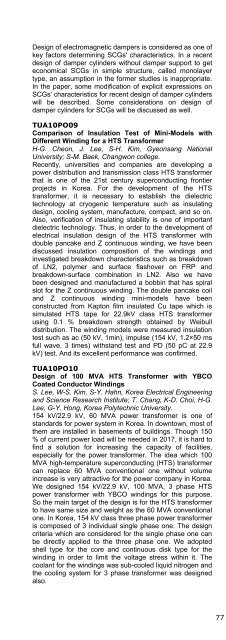Click here to download the abstract booklet in pdf format - MT19 - Infn
Click here to download the abstract booklet in pdf format - MT19 - Infn
Click here to download the abstract booklet in pdf format - MT19 - Infn
Create successful ePaper yourself
Turn your PDF publications into a flip-book with our unique Google optimized e-Paper software.
Design of electromagnetic dampers is considered as one of<br />
key fac<strong>to</strong>rs determ<strong>in</strong><strong>in</strong>g SCGs' characteristics. In a recent<br />
design of damper cyl<strong>in</strong>ders without damper support <strong>to</strong> get<br />
economical SCGs <strong>in</strong> simple structure, called monolayer<br />
type, an assumption <strong>in</strong> <strong>the</strong> former studies is <strong>in</strong>appropriate.<br />
In <strong>the</strong> paper, some modification of explicit expressions on<br />
SCGs' characteristics for recent design of damper cyl<strong>in</strong>ders<br />
will be described. Some considerations on design of<br />
damper cyl<strong>in</strong>ders for SCGs will be discussed as well.<br />
TUA10PO09<br />
Comparison of Insulation Test of M<strong>in</strong>i-Models with<br />
Different W<strong>in</strong>d<strong>in</strong>g for a HTS Transformer<br />
H-G. Cheon, J. Lee, S-H. Kim, Gyeonsang National<br />
University; S-M. Baek, Changwon college.<br />
Recently, universities and companies are develop<strong>in</strong>g a<br />
power distribution and transmission class HTS transformer<br />
that is one of <strong>the</strong> 21st century superconduct<strong>in</strong>g frontier<br />
projects <strong>in</strong> Korea. For <strong>the</strong> development of <strong>the</strong> HTS<br />
transformer, it is necessary <strong>to</strong> establish <strong>the</strong> dielectric<br />
technology at cryogenic temperature such as <strong>in</strong>sulat<strong>in</strong>g<br />
design, cool<strong>in</strong>g system, manufacture, compact, and so on.<br />
Also, verification of <strong>in</strong>sulat<strong>in</strong>g stability is one of important<br />
dielectric technology. Thus, <strong>in</strong> order <strong>to</strong> <strong>the</strong> development of<br />
electrical <strong>in</strong>sulation design of <strong>the</strong> HTS transformer with<br />
double pancake and Z cont<strong>in</strong>uous w<strong>in</strong>d<strong>in</strong>g, we have been<br />
discussed <strong>in</strong>sulation composition of <strong>the</strong> w<strong>in</strong>d<strong>in</strong>gs and<br />
<strong>in</strong>vestigated breakdown characteristics such as breakdown<br />
of LN2, polymer and surface flashover on FRP and<br />
breakdown-surface comb<strong>in</strong>ation <strong>in</strong> LN2. Also we have<br />
been designed and manufactured a bobb<strong>in</strong> that has spiral<br />
slot for <strong>the</strong> Z cont<strong>in</strong>uous w<strong>in</strong>d<strong>in</strong>g. The double pancake coil<br />
and Z cont<strong>in</strong>uous w<strong>in</strong>d<strong>in</strong>g m<strong>in</strong>i-models have been<br />
constructed from Kap<strong>to</strong>n film <strong>in</strong>sulated Cu tape which is<br />
simulated HTS tape for 22.9kV class HTS transformer<br />
us<strong>in</strong>g 0.1 % breakdown strength obta<strong>in</strong>ed by Weibull<br />
distribution. The w<strong>in</strong>d<strong>in</strong>g models were measured <strong>in</strong>sulation<br />
test such as ac (50 kV, 1m<strong>in</strong>), impulse (154 kV, 1.2×50 ms<br />
full wave, 3 times) withstand test and PD (50 pC at 22.9<br />
kV) test. And its excellent performance was confirmed.<br />
TUA10PO10<br />
Design of 100 MVA HTS Transformer with YBCO<br />
Coated Conduc<strong>to</strong>r W<strong>in</strong>d<strong>in</strong>gs<br />
S. Lee, W-S. Kim, S-Y. Hahn, Korea Electrical Eng<strong>in</strong>eer<strong>in</strong>g<br />
and Science Research Institute; T. Chang, K-D. Choi, H-G.<br />
Lee, G-Y. Hong, Korea Polytechnic University.<br />
154 kV/22.9 kV, 60 MVA power transformer is one of<br />
standards for power system <strong>in</strong> Korea. In down<strong>to</strong>wn, most of<br />
<strong>the</strong>m are <strong>in</strong>stalled <strong>in</strong> basements of build<strong>in</strong>gs. Though 150<br />
% of current power load will be needed <strong>in</strong> 2017, it is hard <strong>to</strong><br />
f<strong>in</strong>d a solution for <strong>in</strong>creas<strong>in</strong>g <strong>the</strong> capacity of facilities,<br />
especially for <strong>the</strong> power transformer. The idea which 100<br />
MVA high-temperature superconduct<strong>in</strong>g (HTS) transformer<br />
can replace 60 MVA conventional one without volume<br />
<strong>in</strong>crease is very attractive for <strong>the</strong> power company <strong>in</strong> Korea.<br />
We designed 154 kV/22.9 kV, 100 MVA, 3 phase HTS<br />
power transformer with YBCO w<strong>in</strong>d<strong>in</strong>gs for this purpose.<br />
So <strong>the</strong> ma<strong>in</strong> target of <strong>the</strong> design is for <strong>the</strong> HTS transformer<br />
<strong>to</strong> have same size and weight as <strong>the</strong> 60 MVA conventional<br />
one. In Korea, 154 kV class three phase power transformer<br />
is composed of 3 <strong>in</strong>dividual s<strong>in</strong>gle phase one. The design<br />
criteria which are considered for <strong>the</strong> s<strong>in</strong>gle phase one can<br />
be directly applied <strong>to</strong> <strong>the</strong> three phase one. We adopted<br />
shell type for <strong>the</strong> core and cont<strong>in</strong>uous disk type for <strong>the</strong><br />
w<strong>in</strong>d<strong>in</strong>g <strong>in</strong> order <strong>to</strong> limit <strong>the</strong> voltage stress with<strong>in</strong> it. The<br />
coolant for <strong>the</strong> w<strong>in</strong>d<strong>in</strong>gs was sub-cooled liquid nitrogen and<br />
<strong>the</strong> cool<strong>in</strong>g system for 3 phase transformer was designed<br />
also.<br />
TUA10PO11<br />
Fabrication and Test of Multiple HTS Wire with<br />
Transposition for HTS Power Transformer<br />
W-S. Kim, S. Lee, S-Y. Hahn, Korea Electrical Eng<strong>in</strong>eer<strong>in</strong>g<br />
and Science Research Institute; Y-I. Hwang, K-D. Choi, H-<br />
G. Joo, J-H. Han, H-G. Lee, Korea Polytechnic University.<br />
Accord<strong>in</strong>g <strong>to</strong> <strong>the</strong> recent design of an HTS (High<br />
Temperature Superconduct<strong>in</strong>g) power transformer whose<br />
capacity is hundreds MVA, <strong>the</strong> rated values of <strong>the</strong> low<br />
voltage side current is over thousands amps. Consider<strong>in</strong>g<br />
<strong>the</strong> performance of <strong>the</strong> recent HTS wires, it is <strong>in</strong>evitable <strong>to</strong><br />
use several HTS wires <strong>in</strong> parallel for large rated current.<br />
Lots of stacked HTS wires were fabricated and tested so<br />
far, and <strong>the</strong> results have showed that we have <strong>to</strong> transpose<br />
each wire <strong>in</strong> order <strong>to</strong> reduce <strong>the</strong> AC losses as well as <strong>to</strong><br />
<strong>in</strong>crease <strong>the</strong> current capacity. But many development<br />
programs for HTS transformer reveal that <strong>the</strong> transposition<br />
of <strong>the</strong> several wires dur<strong>in</strong>g <strong>the</strong> w<strong>in</strong>d<strong>in</strong>g process is quite<br />
difficult not only <strong>in</strong> case of <strong>the</strong> layer w<strong>in</strong>d<strong>in</strong>gs but also <strong>in</strong><br />
case of <strong>the</strong> pancake type ones. So, we need transposed<br />
multiple HTS wire which we can handle like s<strong>in</strong>gle wire or<br />
cable for <strong>the</strong> HTS w<strong>in</strong>d<strong>in</strong>gs of large capacity power<br />
transformer. We fabricated many k<strong>in</strong>ds of samples of<br />
multiple HTS wire with transposition <strong>to</strong> apply it <strong>to</strong> <strong>the</strong> HTS<br />
w<strong>in</strong>d<strong>in</strong>gs of power transformer. The electrical<br />
characteristics such as critical currents, distributions of<br />
current, breakdown voltages or AC losses are analyzed by<br />
experiments <strong>in</strong> case by case. F<strong>in</strong>ally we present <strong>the</strong> f<strong>in</strong>est<br />
design of a multiple HTS wire for power transformer.<br />
TUA10PO12<br />
Cont<strong>in</strong>uous Disk Type HTS W<strong>in</strong>d<strong>in</strong>g for High Voltage<br />
Power Transformer<br />
Y-I. Hwang, K-D. Choi, H-G. Joo, J-H. Han, G-W. Hong,<br />
Korea Polytechnic University; W-S. Kim, S. Lee, S-Y.<br />
Hahn, Korea Electrical Eng<strong>in</strong>eer<strong>in</strong>g and Science Research<br />
Institute.<br />
High temperature superconduct<strong>in</strong>g (HTS) w<strong>in</strong>d<strong>in</strong>gs for an<br />
HTS transformer which have been developed have two<br />
k<strong>in</strong>ds of type, one is <strong>the</strong> layer type and <strong>the</strong> o<strong>the</strong>r is disk<br />
type. The disk type w<strong>in</strong>d<strong>in</strong>gs have advantages over <strong>the</strong><br />
layer type ones for a power transformer such as good<br />
<strong>in</strong>sulation and limit of voltage stress. But this k<strong>in</strong>d of HTS<br />
w<strong>in</strong>d<strong>in</strong>g generates excessive AC losses caused by strong<br />
magnetic field component perpendicular <strong>to</strong> <strong>the</strong> surface of<br />
<strong>the</strong> HTS wire. Never<strong>the</strong>less, <strong>the</strong> layer type w<strong>in</strong>d<strong>in</strong>gs have<br />
adopted for an HTS power transformer so far because of<br />
<strong>the</strong> small AC losses of <strong>the</strong> HTS w<strong>in</strong>d<strong>in</strong>gs. We propose a<br />
new w<strong>in</strong>d<strong>in</strong>g method for a high voltage HTS transformer<br />
which has advantages of both types of HTS w<strong>in</strong>d<strong>in</strong>gs, and<br />
we call it cont<strong>in</strong>uous disk type HTS w<strong>in</strong>d<strong>in</strong>g. This new type<br />
of HTS w<strong>in</strong>d<strong>in</strong>g consists of pile of lots of HTS disk w<strong>in</strong>d<strong>in</strong>gs<br />
which have no resistive jo<strong>in</strong>t between <strong>the</strong>m. A pro<strong>to</strong>type of<br />
an HTS w<strong>in</strong>d<strong>in</strong>g was fabricated by <strong>the</strong> new w<strong>in</strong>d<strong>in</strong>g method<br />
we proposed and characteristic test was carried out. The<br />
test result shows that <strong>the</strong> new type HTS w<strong>in</strong>d<strong>in</strong>gs can be<br />
applied <strong>to</strong> HTS power transformers, especially <strong>to</strong> <strong>the</strong> high<br />
voltage ones.<br />
TUA10PO13<br />
Performance Evaluation for a HTS Transformer<br />
A. Formisano, R. Mar<strong>to</strong>ne, Seconda Università Napoli; F.<br />
Marignetti, M. Scarano, Università di Cass<strong>in</strong>o; G. Masullo,<br />
A. Matrone, R. Quarantiello, CRIS.<br />
The adoption of High Temperature Superconduc<strong>to</strong>rs (HTS)<br />
tapes is start<strong>in</strong>g <strong>to</strong> become a suitable and <strong>in</strong>terest<strong>in</strong>g<br />
alternative <strong>to</strong> copper for w<strong>in</strong>d<strong>in</strong>gs <strong>in</strong> transformers, thanks <strong>to</strong><br />
<strong>the</strong> improvement <strong>in</strong> performance and <strong>the</strong> lower<strong>in</strong>g of costs.<br />
Of course, designs different with respect <strong>to</strong> usual layouts<br />
77 MT-19 2005, Genova



